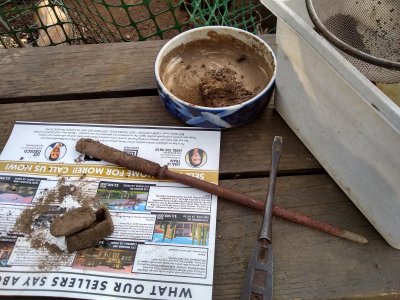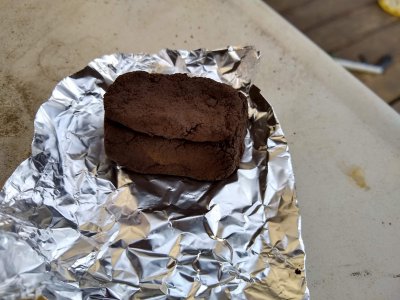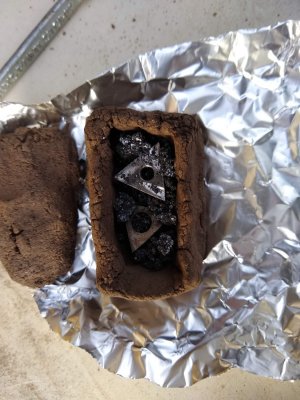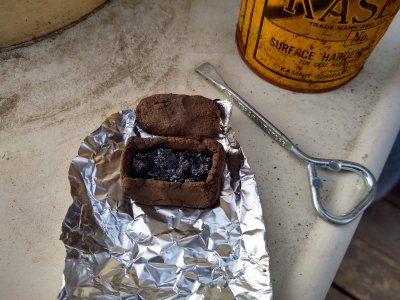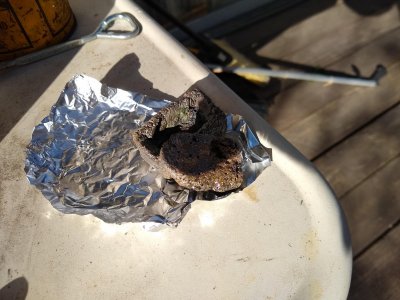I needed a small box to case harden a couple of parts with Kasenit. The can said that the heating should be done for about 20 minutes 1650 F. This is in the range where a steel box would work, but I thought I would try making a clay "crucible." The Internet is full of warnings about beginners trying to make homemade crucibles. Apparently, the main danger is that they will fail when full of molten metal resulting in a hazardous release with the potential of injury. Although the case hardening compound would be expected to liquify, the kinetic viscosity is high enough so it shouldn't splash too much. So it gave an opportunity to try making a homemade crucible.
The recipes can be as simple as half fireclay and grog. The grog is necessary to limit plasticity and shrinkage, which could cause cracks. Crucibles live a hard life with the fast temperature ramp rates. I noticed when digging holes in the garden, there was a clay layer that resists digging and causes poor drainage. Time to mine it! I dug down until the shovel stopped working, and switched to a pickaxe and spud bar. A pail of clay rich soil chunks was extracted and a small amount was forced through a strainer and moistened. Interestingly enough, the plasticity was almost too low to hold together, since there was so much sand in the mixture. It looked like it would lack strength.
Meanwhile, I made a test lump of clay and a little dried piece of air dry clay from Michael's. The air dry clay has lots of plasticity and produces a smooth and strong green body. According to the instructions, it doesn't even need firing due to the fibrous organic material added to it. I set both pieces on a hard firebrick and gave then a little kiss with a swirl flame propane torch (about 2000 F). The air dry clay spalled and exploded almost immediately. It would not have made a workable crucible at all. The homemade clay was very stable at that insane heating rate. It fluxed and matured well, firing to a strong buff body, This test showed that it was ready to go!
The next step was to heat up the box in a toaster oven at max. This should prove it a little more and strengthen it a bit. If it fell apart at this stage, it would be a learning experience. No problem at all. In fact, it rang a little bit after firing.
A layer of Kasenit was placed in the bottom of the box, then the parts were placed over the layer.
Then, the parts were covered with Kasenit, the box shut, and it was placed in the forge to heat from a cold start. The forge heats to operating temperature (about 2300F) in about 10-15 minutes. It was heated for 20 minutes at temperature, then opened and the parts thrown into quenching water. I ended up accidentally touching the box to the water, and it survived. The lid had too much heat due to direct flame impingement and I had to pry it off hot with a screwdriver, which it survived, but it was bubbly.
No cracks, no spills, no expolsions, and the box looks like it can be used again. It seems that I can cautiously proceed with more experiments, but with real fireclay, grog, fluxing agents and scale-up. I am confident that a small crucible like this could handle brass in a more purpose built furnace that doesn't scorch the lid.
The recipes can be as simple as half fireclay and grog. The grog is necessary to limit plasticity and shrinkage, which could cause cracks. Crucibles live a hard life with the fast temperature ramp rates. I noticed when digging holes in the garden, there was a clay layer that resists digging and causes poor drainage. Time to mine it! I dug down until the shovel stopped working, and switched to a pickaxe and spud bar. A pail of clay rich soil chunks was extracted and a small amount was forced through a strainer and moistened. Interestingly enough, the plasticity was almost too low to hold together, since there was so much sand in the mixture. It looked like it would lack strength.
Meanwhile, I made a test lump of clay and a little dried piece of air dry clay from Michael's. The air dry clay has lots of plasticity and produces a smooth and strong green body. According to the instructions, it doesn't even need firing due to the fibrous organic material added to it. I set both pieces on a hard firebrick and gave then a little kiss with a swirl flame propane torch (about 2000 F). The air dry clay spalled and exploded almost immediately. It would not have made a workable crucible at all. The homemade clay was very stable at that insane heating rate. It fluxed and matured well, firing to a strong buff body, This test showed that it was ready to go!
The next step was to heat up the box in a toaster oven at max. This should prove it a little more and strengthen it a bit. If it fell apart at this stage, it would be a learning experience. No problem at all. In fact, it rang a little bit after firing.
A layer of Kasenit was placed in the bottom of the box, then the parts were placed over the layer.
Then, the parts were covered with Kasenit, the box shut, and it was placed in the forge to heat from a cold start. The forge heats to operating temperature (about 2300F) in about 10-15 minutes. It was heated for 20 minutes at temperature, then opened and the parts thrown into quenching water. I ended up accidentally touching the box to the water, and it survived. The lid had too much heat due to direct flame impingement and I had to pry it off hot with a screwdriver, which it survived, but it was bubbly.
No cracks, no spills, no expolsions, and the box looks like it can be used again. It seems that I can cautiously proceed with more experiments, but with real fireclay, grog, fluxing agents and scale-up. I am confident that a small crucible like this could handle brass in a more purpose built furnace that doesn't scorch the lid.


